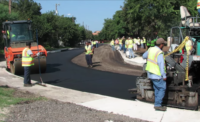Roger Johnson, airport program executive at Jacobs, has over 45 years of construction, construction management, program management, engineering, environmental management and planning experience. As former deputy executive director of Los Angeles World Airports (LAWA), the city authority that owns and operates Los Angeles International Airport (LAX) and Van Nuys Airport, he established its Airports Development Group that completed over $8 billion in capital improvements in seven years.
ENR senior transportation editor Aileen Cho asked Johnson for his thoughts on airport design and construction post-coronavirus. This interview has been edited and condensed.
You spoke on an Airports Council International-North America (ACI-NA) webinar [cosponsored by Airport Consultants Council and Associated General Contractors] on the challenges of COVID-19. What were the major takeaways from the webinar?
The webinar was set up to provide a forum for airport executives to hear how colleagues are addressing the challenges presented by the COVID-19 pandemic to capital improvement programs (CIP). There were a number of major takeaways from my perspective.
In many cases, airports are using the reductions in operation to optimize improvements already underway. For example, Nashville was able to significantly expedite a terminal renovation project by working with the contractor to re-phase the project. A terrazzo replacement project that had approximately 21 phases was now being done in one phase. Austin airport has taken this opportunity to completely renovate its outbound baggage system.
The pandemic has resulted in many airports reassessing their CIPs. However, we did not hear of any airports completely canceling one In many cases, the airports are reassessing the sequence and schedule of implementing certain projects based on demand and current operations. Many airports reported that they are looking at performing deferred airfield projects earlier than previously planned to take advantage of the reduction in operations. In the uncertainty of COVID-19 impacts and duration, airports are focusing on developing projections and “milestones” or “triggers” that will help them make decisions on when to initiate projects.
The last takeaway is that the pandemic has resulted in many airports and airlines working more closely together with respect to facility issues.
Is there anticipation of potential delays in future airport construction opportunities?
Jacobs has already seen some clients delay moving forward with some capacity enhancement projects that are in planning. There appears to be a consensus that aviation will rebound. However, there is also a consensus that the recovery will probably not look like any recoveries we have experienced over the past 20 years. As we look at impacts due to 9/11, SARS, H1N1 and the recession, we can see a fairly consistent recovery pattern. No one has an idea yet of what the global and national recovery pattern is going to look like this time. As a company, I would say that what we are seeing is a shift in construction opportunities from capacity-enhancing to more opportunistic projects taking advantage of the current reduction in operations. As the country opens up and aviation activity is better defined, we expect to see the balance shift back.
How will airports prepare for the potential medium- to long-term scenarios in terms of design and construction? What do you envision as possible scenarios?
There are so many factors that will ultimately impact the answer to this question. However, I believe there are a number of things that airports can and should be doing right now.
Airports need to build flexibility or nimbleness into their capital programs to be able to respond to whatever the recovery looks like. Airports have got to be ready to take advantage of other factors that could impact project schedules. When the recession hit the U.S., the federal government came out with a stimulus bill that provided funding for “shovel-ready” projects. I was managing the then-$4.1-billion LAX development program. When the stimulus funding came out, LAX could only identify one $14-million project that met the definition of shovel-ready. Airports should review their CIPs and look for near-term projects that could potentially be funded.
A part of readiness probably includes an evaluation of projects for both “right-sizing” and potential phasing opportunities. Most CIPs are based on assumptions that may or may not be applicable in today’s environment. Another example of right-sizing in the short term could be considering maintenance as opposed to rehabilitation of pavement. Seal coating pavement can be done at one-tenth of the cost of rehabilitation and may provide several additional years of useful life, giving the airport time to monitor operational recovery.
COVID-19 is also going to change the way we fly. In the near-term, airports have got to start looking at how to respond to health and safety requirements that will be coming. Designs are going to have to consider not only passenger throughput as a function of time (e.g., passengers screened per hour) but also some form of medical monitoring and social distancing as a permanent requirement. Airports need to start working with their tenants and concessionaires to identify potential solutions now, so they are ready to go when the economy starts to rebound.
I believe the key to long-term scenarios is robust industry monitoring. It is going to take some time before any of us understand how aviation is going to respond long-term to this pandemic. Historical operations forecasts are no longer reliable indicators of when projects should be considered.
Are you seeing numerous, or just a few, cases of airport designs that are delayed in construction?
Each airport is responding differently. Some airports have delayed construction, while others are accelerating it. Others still are changing the nature of what they are doing. Austin, Texas has delayed the terminal element of its capital program but is accelerating other elements including enabling projects. LAX has accelerated construction of the Automated People Mover, giving the contractor almost unconstrained access to the Central Terminal Area roadway. Each airport is unique.
What are some potential technologies that could be implemented in post-pandemic airport design?
The way we process passengers and bags is going to change. Social distancing and similar activities designed to reduce potential exposure are here to stay. I believe we are going to see more passengers signing up for biometric screening. We will probably finally come up with a solution for off-site bag drops. We will certainly see self-bag check become the norm. Touchless check-in will probably be accelerated. We have seen several airports running TSA pilot programs on accelerated check-ins.
Food and beverage operations in a post-COVID environment have not yet been finalized. We will certainly see a reduction if not elimination of buffet style dining.
A serious question that will require some significant investigation is how we address social distancing requirements within existing facilities. Current metrics relative to factors such as “level of service” standards in hold rooms and such are going to have to be reevaluated and redefined.
What are your final thoughts on potential long-term effects of the pandemic on your transportation portfolio, with reduced traffic and revenue for roads, rail and airports?
Many of our clients are committed to existing critical projects and programs. While we see a shift in focus from expansion to rehabilitation and maintenance, many of our transportation infrastructure programs and projects are critical and have been sustained by government stimulus packages. We expect that future transportation-related stimulus will catalyze and drive economic recovery.






Post a comment to this article
Report Abusive Comment